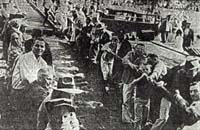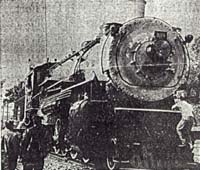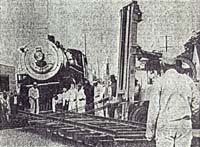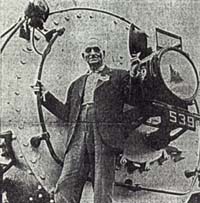THE COLUMBIAN
Monday, September 30, 1957
Willing Hands Tug `Old 539' Onto Final Spur at City Park

EVERYONE GOT INTO THE ACT-The crowd of spectators which assembled in Esther Short Park Saturday to watch the arrival of the gift steam locomotive got a chance to pitch in and help pull the 200-ton engine up a slight grade into the park. The unrehearsed bit of community corporation resulted when air pressure in the engine's boilers was insufficient to boost the monster over the hump. Third man on the left rope is former Vancouver mayor Dr. Ralph Carter. Behind him is Howard Terpenning, park and recreation director. (Vanity Fair-Columbian photo).

"OLD 539" FINDS A NEW HOME-Vancouver youngsters wasted little time in scrambling over the huge frame of the steam locomotive, a gift from the SP&S railroad, after it was finally installed in its exhibit spot in Esther Short Park. Gleaming in a new coat of black and silver paint, the locomotive will remain in the park as a lasting memorial to railroading's steam age. (Vanity Fair-Columbian photo).

PORTABLE ROADBED ROTATED-A lift truck moved 33-foot sections of track in place in front of locomotive No. 539 as the engine make its 31/2-block run from Seventh and Harney Streets to Esther Short Park Saturday morning. About 200 members of the railroad brotherhoods volunteered their time to move the engine, largest to go on exhibit in the Northwest. The entire move was accomplished in about five hours. (Vanity Fair-Columbian photo).

RAILROAD VETERANS HELPED IN MOVE-Reuben E. Brown, 3403 Harney St., a railroad employee for 44 years was one of the engineers who drove locomotive 539 to its new home in Esther Short Park Saturday. Brown, who retired in 1953 after 42 years with the SP&S as engineer and fireman and two years with the Great Northern, was one of several railroad old-timers who turned out for Saturday's operation. (Vanity Fair-Columbian photo)
Oldtimers Watch Move Of Engine
Showing more than a casual interest at Saturdays moving
operation of the Spokane, Portland and Seattle Railway steam locomotive to Esther Short Park were
several of Vancouver's railroading old timers who turned out to take part in or watch the move.
Although they were all proud to have played a significant role in the era of steam railroading and a
little reluctant to see it go, the consensus of the veterans was that diesel power, which put the steam
locomotive out of business is here to stay.
One man, Horace M. Baker, 1025 W. Thirty-ninth St., who started out in 1917, the same year the gift
engine, No. 539, was built and now pilots powerful diesel locomotives for SP&S, said he likes the smooth
efficiency of diesels, but also enjoyed the noise and bustle of the old steam "lokies" like 539 which
operated many times on runs to Wishram and on the Oregon trunk to Bend during the engineer's career
with the SP&S.
DIESELS CLEAN
"The diesels are clean, comfortable and nice to run," Baker said, "but I kind of miss the steam
engines."
Baker, who began railroading at the age of 16 with the Milwaukee Road and joined SP&S in 1936,
friend P. J. Ritter, 3317 E Seventeenth St., were engineers aboard 539 Saturday when it made its last run.
A veteran of 52 years in railroading, James W. Williams, 4009 olive St., was a spectator at Saturday's
operation. Williams, who retired last February, spent 48 year of his career with SP&S and had been an
engineer since 1910. He recalled many times he rushed No. 539 freight runs up the Coumbia River Gorge
to Wishram, and said it was a good engine.
"ROCKING CHAIRS"
Having engineered locomotives through the height of the steam era and took part in the rise of diesel
power to dominance in railroading Willims readily admits the superiority of diesel. "I think it's swell - just
like (text missing) said, "but I'm going to try to get down to the dedication next Friday."
Cooper retired from railroading in 1935 after 42 years with the Illinois Central, Chicago and
Northwestern, Northern Pacific and SP&S railroads.
Locomotive Rests Inside Link Fence
A fitting climax to the 3-1/2 block move Saturday for "Old 539," the SP&S railroad's gift to the city of
Vancouver, say several hundred of the town's citizens and youngsters lend a hand to pull the 200 tons of
steam engine onto its final resting place in Esther Short Park.
The gleaming jet black locomotive started its journey at Seventh and Harney Streets at 8am sharp and
moving at the rate of a block an hour, was at the edge of the park at 12:50 pm, railroad time.
Slim crowds, mostly railroaders, watched the moving operation at its start, but by the time the
locomotive reached Esther Short Park an estimated 1,000 people were on hand. Many of them took an
active part in helping the locomotive get up and over the slight grade into the park itself.
ROPES USED
Air pressure supplied by two city compressors and to SP&S trucks chugged and winched the engine
down Seventh to Esther Street, but when the time came to pull the locomotive, the largest one on exhibit
in the Northwest, up the grade into the park, two 100-foot ropes were attached to the cow catcher and an
oversupply of willing hands tugged No. 539 into place.
A final blast from the engine's whistle when the locomotive was brought to a halt on the short stretch
of permanent railroad bed in the park was answered with whistles and cheers from the crowd.
About 200 railroad employees, members of the railroad brotherhoods, volunteered their time to
accomplish the tough task of moving the locomotive.
TRACK MOVED
Several 33-foot sections of portable track were rotated to provide the roadbed up Seventh Street. After
the engine moved about 60 feet at a time, section gangs unbolted two sections at the rear of the engine and
a lift truck carried them to the front where they were bolted on to provide an additional 50 feet for travel.
Very little difficulty was encountered during the entire, smoothly executed operation. Skilled men
who knew their jobs hustled the engine down the street without an accident and with a minimum of
confusion.
The engine and tender, measuring better than 80 feet in length now rests within a six-foot high
rectangle of chain link fence, deemed necessary to prevent vandalism and injury when the exhibit is not
supervised.
Click on above images for larger view

Story and photographs reprinted with premision from The Columbian Newspaper located in Vancouver, Washington.




